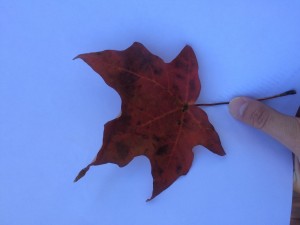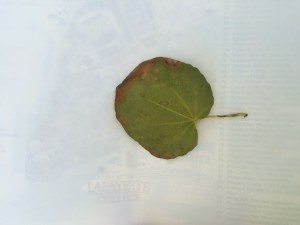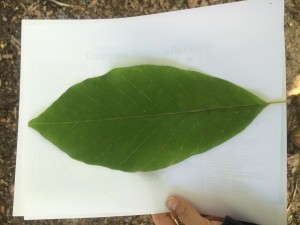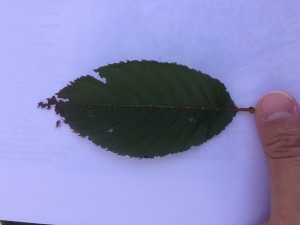At Metzgar, as I believe I blogged about previously, the corn and bean fields in the surrounding area of the complex have been harvested, leaving a very flat field behind. Since then, every day that we have had practice out there, we have seen at least one white tailed deer moving through the newly cleared field. The time is always around dusk, but I find it so funny to see the deer moving through such open areas. The only time I used to really see deer was in the remote woods of Vermont. I know that they are a bit of an infestation here and in New Jersey particularly but it is so unnatural to see these large mammals moving around in such open areas when I am used to catching a glimpse of them from behind the trees before they prance away into the woods for better coverage and safety.
Author Archives: Tessa Broholm
Passages of Interest
“What can you think of a bird that crashes into glass and creeps headfirst down the trunk of a pine?” (50 Watching the Birds)
I understand the point he was trying to make here but still, the point of crashing into glass is a problem created by humans. This just makes me think of all we have learned and seen with birds hitting glass, especially around campus.
“For a lifetime or two, or maybe three, I think I’ll settle for the sedate career, serene and soaring, of the humble turkey buzzard…And contemplate this world we love from a silent and considerable height” (55 Watching the Birds).
This paints a tempting picture, if reincarnation were real. The idea of being able to observe the world from the highest of heights and to know what’s going on below but being able to choose to not be involved, that sounds like a dream.
“In the spring the wish to wander is partly composed of an unnamable irritation, born of long inactivity; in the fall the impulse is more pure, more inexplicable, and more urgent” (249 Northing).
I think this is beautifully said and very accurate. In spring there is a sense of restlessness, mainly to do with no longer having to be cooped up, but in the fall, there is a sense of urgency, perhaps even danger, that drives the restlessness.
Hope for the Future
http://www.nytimes.com/2015/11/06/world/climate-change-pew-global-survey.html?rref=collection%2Fsectioncollection%2Fscience&action=click&contentCollection=science®ion=stream&module=stream_unit&version=latest&contentPlacement=3&pgtype=sectionfront&_r=0
This article surveys many different people about their views on climate change. The biggest point of the survey is that the majority of people in the 40 countries surveyed acknowledged that climate change is a problem and that measures need to be taken. I am personally excited by this because the first step to making a change is knowledge and being informed. With the general public having a consensus on the fact that it is a problem, perhaps now political leaders will actually spend more time working to help solve this problem.
Passages of Interest
“What I have observed of the pond is no less true in ethics. It is the law of average. Such a rule of the two diameters not only guides us toward the sun in the system and the heart in man, but draws lines through the length and breadth of the aggregate of a man’s particular daily behaviors and waves of life into his coves and inlets,and where they intersect will be the height of depth of his character” (Walden 315).
“The murmur of the pine’s green branches isa in her ears, she remembers how the white heron came flying through the golden air and how they watched the sea and the morning together, and Sylvia cannot speak, she cannot tell the heron’s secret and give its life away” (The White Heron 1207).
“The exploration and conquest of the northern United States and Canada were propelled in large part by the economic rewards of dinging, catching, killing, eviscerating, and skinning these fifty-pound aquatic rodents” (Nature Wars 69).
“Based on the head and thrown away? He’s right, but that’s not what the voters I talked to thought they had approved. The clear message of the anti trapping forces was: Vote for this initiative and animals won’t die” (Nature Wars 84).
On Hunting
“‘You’re both talking rot,’ said Margot. ‘Just because you’ve chased some helpless animals in a motor car you talk like heroes'” (Hemingway 2025).
This passage reminded me of the discussion we had in class last week about hunting, especially the point that Owen made about his own family and how the people who continue to hunt are in it for the whole experience and not just for the killing part. This point neatly overlapped into the biology course I am currently taking. Last week we talked about commercial whale hunting and the moratorium that is currently in place. One of the exceptions to the moratorium is for indigenous people, such as the Inuits. They are allowed to continue hunting whales because they have low impact on the populations, but also because whales are a integral part of their culture. When they catch a whale, they use all of the whale and share it with their village, unlike commercial whaling which leaves a lot to waste.
Passages of Interest
“A complicating extension of the idea of man the despoiler was a resurrected belief that the natural world was a benign place in which creatures lived in harmony with one another. The idea was in striking contrast to the amorality of a Darwinian nature that was indifferent and random, its creatures living in a world of predators and prey, struggling to war, reproduce and survive” (Sterba xvii).
“‘After seeing Bambi nobody wants to kill a deer'” (Sterba 110).
“They argued that people had invaded the habitat of the geese with their subdivisions, malls, and sprawl, so people had a special obligation to live in harmony, or at the very least coexist, with the birds” (Sterba 125).
Metzgar’s Bean Fields
The Metzgar sports complex is mostly surrounded by corn fields. The corn has long died and is now drying out slowly. If you move along the cross country course, away from Metzgar and towards the intramural fields, you find yourself running through a corridor with corn towering high on your left and beans cowering to the right. Even though the beans are very low to the ground, they still had a significant presence that I only noticed today when they had been removed this weekend by however owns the land. The barren fields opened up the area and I could see directly to the suburban houses on the road several hundred meters away. Before the harvest, there is some feeling of being enclosed by the fields, but once all of the crops have been removed, there is nothing there to cut the view or the wind, literally make Metzgar feel colder and less inviting of a place. Even though this “nature” is man made and cultivated, it still has comforting affects when it is present.
The Quest for Panther Mountain
We hit the trail on a crisp morning and at a brisk pace. The pace was set not only by the desire to warm up and the length of our strides but also by the desire to reach the allusive point named Giant Ledge. How giant could it really be? I had to know. As it turned out, our pace was too brisk, as we stopped several times to allow the others behind us catch up. As we waited, our bodies cooled and thus as the gathered again as a group, we were more than eager to take off again to warm up. It did not take long to reach the ledges but the view was still marvelous. I had not realized the elevation we had gained from our drive in to the mountain and from the burn in our quads. The ledges opened up suddenly to a breath taking view of the valley. Even though it was not a clear day, ridges of mountains far beyond could be seen from our vantage point. I wondered how far we may actually be able to see, perhaps into Connecticut or Massachusetts or Pennsylvania, depending on our orientation. After the thrill of the ledges, we learned that we were to continue onwards towards Panther Mountain. Somebody mused, “I wonder if this is like Fox Hollow, named for something that is no longer here.” I thought that was a good point. The front of the group was raring to go, I among them. I could only imagine what was waiting for us on the mountain, what views and what scene would be laid out before us as we stood on top of the world. We only made it part of the way before we realized that our destination as a group was unrealistic. It may have been possible under different circumstances, but today was not the day.The itch to go just a little bit further had to be put out of mind, as we turned around and headed back down the path we had ascended earlier in the day. Should I get the opportunity again, I will make sure to reach the peak and quench my thirst for the feeling of success that comes with summiting yet another mountain.
Passages of Interest
“Some of the paintings show landscapes full of the tree stumps. The stumps were symbols of progress and points of pride… To let precious land, cleared by backbreaking labor, go untended, unprotected from an invasion of trees, was the opposite of progress” (Sterba 36).
This passage was a very interesting insight to some general thoughts of people from the past. Now in a conservationist mentality, I was surprised to think of the labor that went into removing the forest and the pride that people must have felt for being able to do that.
“Sometimes the forest isn’t what it seems to be. All sorts of outdoor entrepreneurs offered forays into the “wilderness” beginning in the 1980s…This wasn’t bad. It was just deceptive- the equivalent of restaurants that offer “wild” game that was farm raised because, as we shall see, it is illegal in the United States to sell real wild game” (Sterba 42-43).
I enjoy this comparison. It gives a new spin on the idea of how wilderness as most Americans choose to experience it, isn’t really what we would define as true wilderness.
“There was only a narrow slit between their lids, by which eyes, looking out from the land of dreams, and endeavoring to realize me, vague object or mote that interrupted his visions” (Thoreau 289).
I don’t think that Thoreau is saying anything particularly important here, I was simply impressed by the construction of this sentence.
Lafayette’s Tree Collection
While I find it to be a noble idea to create an application that allows for near-instantaneous identification of species based on pictures of leaves, this app was fairly inaccurate. With combined help from the outdated map of campus, I was able to identify the leaves and usually found them further down on the list of suggestions. There was one leaf by Kirby that I was unable to identify, although the leaves were quite large – I would’ve thought that the app would have some way of measuring the size of the leaf for assistance in identification. Below are a sampling of some of the leaves found on the quad surrounding the Kirby dorm. The leaves had recently been cleared away by maintenance so there weren’t an abundance of leaves on the ground to choose from. Interestingly enough, the Yoshino cherry was the only leaf actually picked off the tree and even though it is not native, it was the only leaf that showed some evidence of critter damage. It also had a beetle on it as you can see to the bottom of the leaf in the photo. The maple was the only native plant that I identified.
Sugar Maple
Katsura Tree
(unidentified)
Yoshino Cherry




